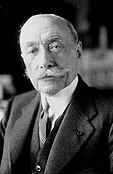Wikipedia:Main Page history/2023 December 30b
From today's featured article
André Messager (30 December 1853 – 24 February 1929) was a French composer and conductor, whose best-known works are the ballet Les Deux Pigeons (1886) and the opéra comique Véronique (1898). His successes span the period from the late 19th century (Les p'tites Michu, 1897) to early 20th century (Monsieur Beaucaire, 1919), including musical comedies with Sacha Guitry and Yvonne Printemps. Many of his works were also produced in the West End and some on Broadway, some with long runs and numerous international revivals. Messager became a major figure in the musical life of Paris and then London, as a composer and as a prominent conductor in the concert hall and opera house, leading the Paris Opéra, among others. His music was known for its melodic and orchestral invention, musical craftsmanship, and characteristically French elegance and grace. Although most of his works have been infrequently revived, historians of music consider him the last major figure in French opéra comique and opérette. (Full article...)
Did you know ...
- ... that before photographer Philippe Halsman decided to photograph three cats flying through the air (pictured), surrealist artist Salvador Dalí had wanted to blow up a duck with dynamite?
- ... that Jack Washburn was called "Cinderella Boy" for winning a starring role in his first Broadway show?
- ... that the India national team were victorious in football at the 1951 and 1962 Asian Games?
- ... that Bob Albright won his first primary election for the Alabama House of Representatives against a neighbor who lived on the same street as him?
- ... that the allegedly haunted Capitol Hill mystery soda machine "went for a walk" one day and never returned?
- ... that teacher Mary Creighton Bailey was awarded the Order of Merit of the Federal Republic of Germany for her services in the improvement of education in Germany shortly after World War II?
- ... that a winter storm in December 2017 cancelled an attempt at the world's largest snowball fight at Six Flags Great Adventure in New Jersey?
- ... that Colonel Sanders created a competing restaurant to KFC, and was sued by KFC?
In the news
- In Nigeria, bandits kill at least 200 people in Plateau State.
- A mass shooting in Prague, Czech Republic, leaves 15 people dead.
- Pope Francis (pictured) approves a declaration that allows Catholic clergy to bless same-sex couples.
- After weeks of earthquakes, a volcanic eruption occurs near Grindavík, Iceland.
- An earthquake in Jishishan County, China, leaves more than 140 people dead.
On this day
December 30: Rizal Day in the Philippines (1896)
- 1702 – Queen Anne's War: James Moore, the British colonial governor of Carolina, abandoned a siege against St. Augustine in Spanish Florida and retreated to Charles Town in disgrace.
- 1813 – War of 1812: British forces captured Buffalo, New York, and burned down nearly all its buildings.
- 1940 – The Arroyo Seco Parkway (pictured), one of the first freeways built in the U.S., connecting downtown Los Angeles with Pasadena, California, was officially dedicated.
- 1958 – The Guatemalan Air Force fired on Mexican fishing boats that had strayed into Guatemalan territory, triggering an eight-month conflict.
- 2013 – Supporters of Congolese religious leader Paul-Joseph Mukungubila carried out a series of attacks on television studios, the airport and a military base in Kinshasa.
- Giovanni Baglione (d. 1643)
- Anna Blackburne (d. 1793)
- Elena Landázuri (b. 1888)
- C. Harold Wills (d. 1940)
Today's featured picture

|
Diamond is a solid form of carbon with its atoms arranged in a crystal structure known as diamond cubic. It is metastable at standard temperature and pressure, converting to the chemically stable form graphite under those conditions but at a negligible rate. Diamond has the highest hardness and thermal conductivity of any natural material, properties that are useful in major industrial applications such as cutting and polishing tools. In addition to its industrial uses, diamond is much sought-after as a gemstone for use in jewelry. Most natural diamonds were formed between 1 billion and 3.5 billion years ago, at depths between 150 to 250 kilometres (93 to 155 mi) in the Earth's mantle. They were then carried to the surface more recently in volcanic eruptions and deposited in igneous rocks known as kimberlites and lamproites. This photograph shows the cathodoluminescence of a round-cut diamond, taken with the use of a scanning electron microscope. The image has a field of view of 3.45 millimetres (0.136 in). Photograph credit: Pavel Somov
Recently featured:
|
Other areas of Wikipedia
- Community portal – The central hub for editors, with resources, links, tasks, and announcements.
- Village pump – Forum for discussions about Wikipedia itself, including policies and technical issues.
- Site news – Sources of news about Wikipedia and the broader Wikimedia movement.
- Teahouse – Ask basic questions about using or editing Wikipedia.
- Help desk – Ask questions about using or editing Wikipedia.
- Reference desk – Ask research questions about encyclopedic topics.
- Content portals – A unique way to navigate the encyclopedia.
Wikipedia's sister projects
Wikipedia is written by volunteer editors and hosted by the Wikimedia Foundation, a non-profit organization that also hosts a range of other volunteer projects:
-
Commons
Free media repository -
MediaWiki
Wiki software development -
Meta-Wiki
Wikimedia project coordination -
Wikibooks
Free textbooks and manuals -
Wikidata
Free knowledge base -
Wikinews
Free-content news -
Wikiquote
Collection of quotations -
Wikisource
Free-content library -
Wikispecies
Directory of species -
Wikiversity
Free learning tools -
Wikivoyage
Free travel guide -
Wiktionary
Dictionary and thesaurus
Wikipedia languages
This Wikipedia is written in English. Many other Wikipedias are available; some of the largest are listed below.
-
1,000,000+ articles
-
250,000+ articles
-
50,000+ articles




